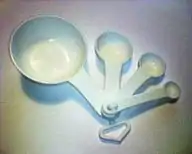Cookbook | Lists
Recipes from different parts of the world use different units of measurement. This page is a guide to those that are most commonly used in cooking.
List of Units
Volume
- teaspoon (also t or tsp.)
- tablespoon (also T, tbl., tbs., or tbsp.)
- fluid ounce (also fl oz)
- gill (about 1/2 cup)
- cup (also c)
- pint (also p, pt, or fl pt - Specify Imperial or US)
- quart (also q, qt, or fl qt - Specify Imperial or US)
- gallon (also g or gal - Specify Imperial or US)
- ml, also milliliter, millilitre, cc (and mL only in the US, Canada and Australia).
- l, also liter, litre, (and L only in the US, Canada and Australia).
- dl, also deciliter, decilitre (and dL only in the US, Canada and Australia).
Mass and Weight
Length
Temperature
See the oven temperature table.
Metric Units
Metric units are made up of a base unit and a scale modifier. Each type of measurement has its own base unit. The modifiers are shared between all units. The relevant base units for cooking are:
- Mass: gram (g)
- Length: meter (m)
- Volume: cubic meter (m3)
Commonly used prefix modifiers are:
- 1/1000 milli (m)
- 1/100 centi (c)
- 1/10 deci (d)
- 100 hecto (h)
- 1000 kilo (k)
In cooking the old unit Liter (l) is commonly used to measure volume. One liter is (exactly) equal to 0.001 cubic meters, or 1 cubic decimeter, written like: 1 l = 1 dm3. The prefix modifiers can be used with any unit and thus 1 cl (centiliter) is equal to 1/100 of a liter. The unit for volume is derived from the unit for length. Two lengths forms an area, which is length x length and has the derived unit square meter (m2). Three lengths forms the volume metric m3. This has the consequence that a m3 is equal to 1000 dm3, that is 103 = 10x10x10.
Examples relevant for cooking:
- 1 l = 10 dl = 100 cl = 1000 ml = 1 dm3 = 0.264 US gallons
- 1 kg = 10 hg = 1000 g = 2.2 pounds
- 1 cm = 0.39 inches
Some recipes in Wikibooks Cookbook use American measurement units (pounds and ounces, Fahrenheit, fluid ounces and pints, etc.) and some recipes use metric units (grammes and kilograms, Celsius, milliliter, etc.). An attempt to ensure that all Cookbook recipes use metric units (alone or alongside American units) is an ongoing job. A list of recipes which have been confirmed as having metric units can be found here.
Avoirdupois Conversion Reference
Volume
- American (US) units
- 1 T = 3 t = 1/2 fl oz
- 2 T = 1 fl oz
- 1 cup = 16 T = 8 fl oz
- 1 pint = 2 cups = 16 fl oz
- 1 qt = 2 pints
- 1 gal = 4 qt
Mass
- 1 lb = 16 oz
Mass/Volume conversions
Approximate conversions based on water density. These conversions are useful for more than just water. Although other things have different densities, they are good enough for most estimates.
- 1 fl oz = 1 oz
- 1 pint = 1 lb
- 2 cups = 1 lb
Water has a density of exactly 1 g/cm³
- 1 mL = 1 g
- 1 L = 1 kg
An American stick of butter is 1/4 lb, and is divided into 8 tablespoons. So, 1 tbsp butter = 1/2 oz butter.
Kitchen measures around the world

Sweden
Sweden uses the following standard set of volume measures in recipes. (In the picture, from left to right, deciliter, tablespoon, teaspoon and milliliter.) All are metric, with the tablespoon defined as exactly 15 ml and the teaspoon as exactly 5 ml.
- deciliter (dl) = 100 ml
- tablespoon ("matsked", msk) = 15 ml
- teaspoon ("tesked", tsk) = 5 ml
- milliliter ("kryddmått", krm) = 1 ml
Finland
Finland uses the following abbreviations.
- tablespoon ("ruokalusikka", rkl) = 15 ml
- teaspoon ("teelusikka", tl) = 5 ml
See also
- {{Metricate}}
- The Best and Most Accurate Way to Measure Wet and Dry Ingredients for Baking: spooned flour is less dense (weights less) than scooped flour.